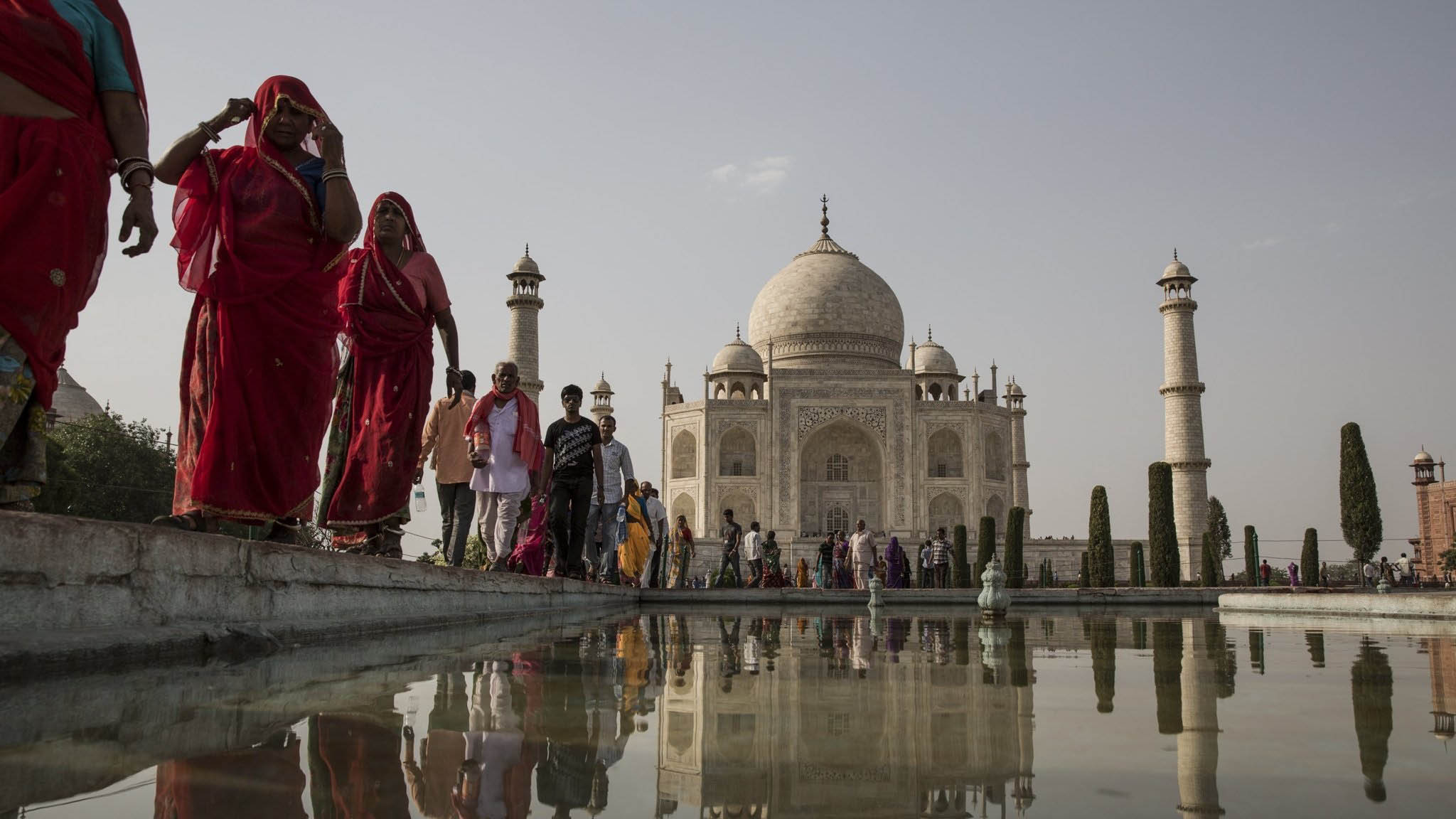
An office bearer of BJP Ayodhya unit has filed a PIL before the Lucknow Bench of the Allahabad High Court pleading that Taj Mahal is a temple — Tejo Mahalaya, even as he prayed for grant of permission to worship in the monument’s premises, reports Mudit Mathur
The old controversy over Taj Mahal is reignited by saffron leaders – whether Taj Mahal is a tomb or a temple? The controversy travelled from the Agra Civil Court to High Court and even before the Supreme Court with no anticipated relief. Even the originator of this controversial theory Purushottam Nagesh Oak (P.S. Oak) was reprimanded by the Supreme Court for such claims over the Taj Mahal to be a “TejoMahalaya”, a Lord Shiva temple, but his saffron followers continue to repackage the same issue again and again with different identities.
Despite clear stand of Modi government on the issue, an office bearer of BJP Ayodhya unit has now filed another Public Interest Litigation before the Lucknow Bench of the Allahabad High Court with same pleadings about Taj Mahal to be a temple – known as “Tejo Mahalaya,” and right to worship be allowed by declaring the provisions of the Ancient and Historical Monuments and Archaeological Sites and Remains (Declaration of National Importance) Act, 1951 (71 of 1951) and the Ancient Monuments and Archaeological Sites and Remains Act, 1958, unconstitutional being ultra vires to Article 19 (1) (a), 25, 26, 49 and 51-A (f) (h) of the Constitution of India.
Interestingly, all the litigations raised up in the Taj Mahal controversy taking motivated Hindutva angle, relied upon a book published by P.S. Oak titled “Taj Mahal: The True Story.” The author himself failed to convince the apex court and academic world with the authenticity of his alleged claims. Further, the Narendra Modi-led government informed the Lok Sabha on 30th November, 2015 that it has found no evidence that the Taj Mahal in Agra was a Hindu temple as claimed by P S Oak.
The Taj Mahal is a UNESCO World Heritage site and Indian government has rejected claims by a group of lawyers that the Taj Mahal monument was a Hindu temple. The then Union Culture Minister Mahesh Sharma told the Lok Sabha that the government didn’t find any evidence that Taj Mahal, the 17th century Mughal monument, was a Hindu temple. The response came in the wake of a controversy which erupted after a declaratory suit was filed by a group of advocates in Agra Civil Court to have the Taj Mahal declared as a Hindu Temple and the right to offer worship in the Taj Mahal.
Interestingly, the lawyers in their suit have named Lord Agreshwar Mahadev Nagnatheswar Virajman as main plaintiff to the claim of ownership of the property, as has been successfully done in the case of Ayodhya dispute to claim ownership rights. The suit claiming that the Taj Mahal was originally a Shiva temple and demanded permission for worship for Hindus and restriction for Muslims from offering prayers at the location.
The Taj Mahal is a white marble mausoleum located on the southern bank of the Yamuna river in the Indian city of Agra. It was commissioned in 1632 by the Mughal emperor Shah Jahan to house the tomb of his favourite third wife, Mumtaz Mahal. One of the seven wonders, the Taj Mahal is regarded by many as the best example of Mughal architecture and is widely recognized as “the jewel of Muslim art in India”. On 7 July 2007, it was declared one of the seven winners of New 7 Wonders of the World (2000–2007) initiative in Lisbon.
The right-wing writer, P N Oak, in his book – “Taj Mahal: The True Story”, claimed: The Taj Mahal was originally a Shiva temple and a Rajput palace named “Tejo Mahalaya” seized by Shah Jahan and adopted as a tomb. This temple might have been built by Indian King Jai Singh I. Mahal is a word to describe a royal palace and not a tomb and after seizure by Shah Jahan, the name was changed to Taj Mahal.
Oak’s claim is based on some western authorities on architecture including Ernest Binfield Havell, Mrs Kenoyer and William Wilson Hunter who have written that the Taj Mahal is built in the Hindu temple style. Asserting this, Havel says the plan of the ancient Hindu temple of Java, the Prambanan, is identical with that of the Taj Mahal. The octagonal shape of the Taj Mahal has a special Hindu significance, because Hindus alone have special names for the eight directions and the celestial guards assigned to them. The finial of the Taj Mahal is a Trishul with a Kalash, holding two bent mango leaves and a coconut, which is a sacred Hindu ritual’s theme.
As founder and president of the Institute for Rewriting Indian History, the former official, P.N. Oak, is the author of 15 books asserting that the Mughal and other Muslim rulers merely desecrated and occupied architectural masterpieces that were designed by Hindus. However, most of the historians do not subscribe to his views based on unsustainable evidences. Oak asserts in his book that the monument is a 12th-century Hindu temple that was converted into a palace by Muslim rulers and commandeered by Shah Jahan to serve as his wife’s tomb. Most of the historians disagree with his claims and maintain that the Taj Mahal was built in the 17th century at Agra in northern India on the orders of Shah Jahan, the Mughal emperor, after the death of his favourite wife, Mumtaz Mahal.
Many historians say that Oak was not a historian nor an archaeologist or a linguist. He was a soldier in the Indian National Army of Subhash Chandra Bose. Subsequently, he worked as a journalist. His books and writings revolve on four central themes: 1 All cultures in the world originated from Indian culture. 2 All languages in the world originated from Sanskrit. 3 All religions in the world are sects of Hinduism or originated from Hinduism. 4 What is referred to as Bharat in ancient texts refers to the whole world.
On Taj Mahal controversy the noted historian Rana Safvi, quoting W.E. Begley (Contributor), Z.A. Desai’s book entitled “Taj Mahal: The Illumined Tomb: An Anthology of Seventeenth-Century Mughal and European Documentary Sources, said that “there is no question” of revisiting the history of the Taj Mahal, and that there is no evidence a temple ever existed on the site. “There was a haveli [mansion] owned by Hindu ruler Jai Singh which existed before the Taj was built there. “Shah Jahan officially bought the haveli from him. An official farman [order] was issued about this and it still exists. The farman also shows that the Mughals were very particular about recording their deeds and history,” she said. Another noted historian, Harbans Mukhia, also agrees to her views. “Recorded history proves beyond any doubt that the Taj Mahal was built by Shah Jahan in memory of his queen,” Mukhia said. “School text books and various government websites also describe the monument as an example of Indo-Islamic architecture,” he added.
The petitioner of the present PIL, Dr Rajneesh Singh, is the media in charge of the BJP Ayodhya unit. “I have been trying to ascertain facts about the 22 locked rooms of the Taj Mahal since 2020 through the Right to Information Act (RTI),” Singh said adding that I filed an RTI in 2020 with the union ministry of Culture seeking information about the rooms. Replying to the RTI, the union ministry of Culture informed the Central Information Commission (in Delhi) that these rooms were locked due to security reasons,” Singh said. And no detail was provided about these rooms, he added.
“When all my efforts failed then I approached the Lucknow High Court seeking directives to the government to open these 22 rooms and constitute a fact-finding committee to find out whether Hindu gods and scriptures are inside,” he added. The PIL expressed apprehensions of communal clashes as happened in Ayodhya because some saffron clad Jagadguru Paramhans Acharya was stopped to enter Taj Mahal where he went to worship Lord Shiva.
The petition also sought mandamus with regard to certain provisions of the Ancient and Historical Monuments and Archeological Sites and Remains (Declaration of National Importance) Act 1951, and the Ancient Monuments and Archeological Sites and Remains Act 1958, to be unconstitutional under which the Taj Mahal, Fatehpur Sikri, Agra Fort, Itimad-ud-Daulah’s tomb and many monuments all over India were declared protected historical monuments. Besides, it prayed for other directions to constitute fact finding committee and opening up 22 closed room inside the Taj Mahal to ascertain facts and truth.
The Uttar Pradesh is just witnessing spurt of communal tides over pre-independence contentious conflicts by right-wing hardcore Hindutva forces despite existence of the Places of Worship (Special Provisions) Act, 1991, whereby it was declared that the religious character of a place of worship existing on the 15th day of August, 1947 shall continue to be the same as it existed on that day.
It was further provided in Section 4(2) of the Act 1991, that any suit, appeal or other proceeding with respect to the conversion of the religious character of any place of worship, existing on the 15th day of August, 1947, is pending before any court, tribunal or other authority, the same shall abate, and no suit, appeal or other proceeding with respect to any such matter shall lie on or after such commencement in any court, tribunal or other authority.
But despite legislation barring the jurisdiction, the Civil Courts are entertaining claims of right to worship at the Shrigar Gauri temple located in Gyanvapi mosque premises adjoining Kashi Vishwanath temple and Shahi Idgah mosque near the Krishna Janmabhoomi temple in Mathura.
Court dismisses PIL, says plea nonjusticiable
The Lucknow bench of Allahabad High Court on Thursday dismissed a plea to constitute a fact-finding committee and the “opening of 22 rooms” on the monument’s premises to find out the “real truth” behind the Taj Mahal construction, calling it a “non-justiciable” issue. A non-justiciable issue is something, which the Court cannot decide or go into.
During the hearing, Justices Devendra Kumar Upadhyay and Subhash Vidyarthi said, “We are of the opinion that petitioner has called upon us to give a verdict on completely a non-justiciable issue. “The first prayer (to constitute a fact-finding committee to study “real history” of Taj Mahal) cannot be adjudicated by this court,” the bench ruled.
“We are not convinced with your prayers. What are you seeking is the exploration of facts through a fact-finding committee? That’s none of your rights and it’s not under the ambit of the RTI Act,” the bench contended.
The judges also ridiculed the petitioner who sought a declaration that certain provisions of the Ancient and Historical Monuments and Archaeological Sites and Remains (Declaration of National Importance) Act 1951, to be ultra-vires, which stood repealed about sixty-four years ago.












